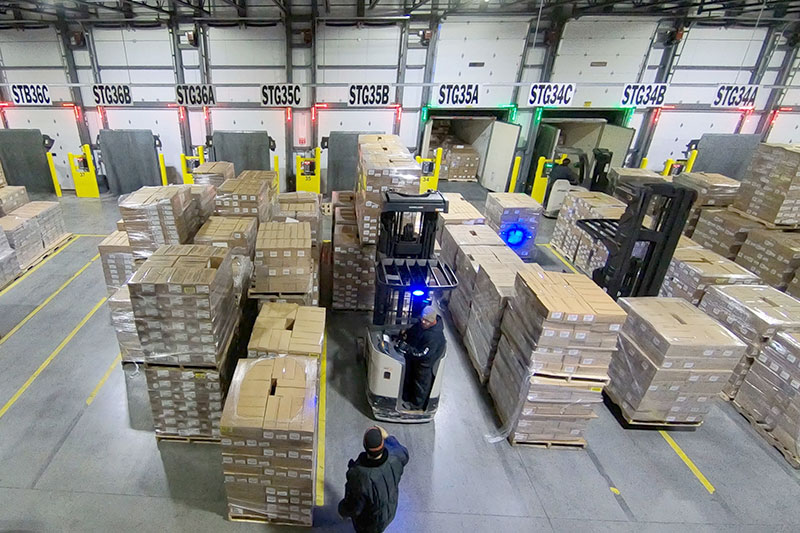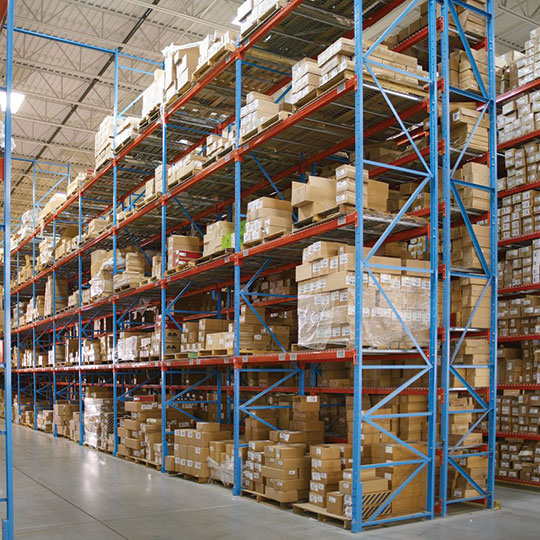Where conventional warehousing fits
With all the emphasis these days on automation, conventional warehousing is often overlooked if not forgotten. In fact, conventional warehousing is alive, well and thriving even at high-volume facilities and in e-commerce.

Not everyone has a need for automation,” says Ian Hobkirk, senior vice president of consulting for business development at KPI Integrated Solutions.
“Not everyone has the budget. The ROI. The business case. Or the need for the risk that goes with automation,” Hobkirk adds.
So, what exactly is the case for conventional warehousing in a distribution world seemingly obsessed with automation?
That’s what we asked a panel of experts that includes suppliers of conventional warehousing equipment, automation and software as well as consultants. Here’s what they had to say.
What’s it look like?
Let’s start with what conventional warehousing looks like. And to be honest, it wasn’t especially difficult to get consensus here.
Basically, conventional warehousing has lift trucks and rack. There’s nothing wrong with floor stacking, either. On the information side, you have bar code scanners, voice systems and radio frequency communications. Add to that a warehouse management system (WMS).
Then our experts started to nibble on some other elements. Some included limited use of conveyors and even autonomous robots. Others included warehouse execution systems (WES). Put walls were mentioned in passing as were case pick modules with WES support.
For most, pretty much all other materials handling equipment as well as data management and software systems are out of bounds. However, Kyle Nevenhoven, principal consultant at automation supplier Dematic, had the tightest definition of conventional warehousing with no nibbling. “Conventional is well suited to a warehouse with limited order complexity and a relatively low SKU count,” he says.
All of which is good, but what are key characteristics of conventional warehousing?
“A conventional warehouse is very fluid. It doesn’t have fixed constraints [beyond rack] like conveyor bolted to the floor. That makes these facilities highly flexible,” explains Ryan Wachsmuth, Steel King’s dynamic storage sales manager.
“Conventional is a good fit for new companies as well as those that are heavily seasonal, but have a standard order mix and very repeatable processes,” says Diana Mueller, account executive at Fortna.
“Even in the face of high volume, conventional warehousing is not a wrong answer,” says Bryan Jensen, chairman and executive vice president at St. Onge. And, he says, that’s the case whether the facility is dominated by full pallet moves in food and beverage or retail e-commerce eaches.
“The viability of conventional warehousing is all about work content and labor level. As both move up the scale and it takes longer to process an order, conventional warehousing begins to become less promising,” Jensen adds.
Unless, of course, some software is brought in, says Dan Gilmore, vice president of marketing at Softeon.

When conventional comes up short
That gets us to the line of demarcation between conventional, mechanized and automation. Yes, it’s fuzzy and requires thoughtful evaluation to decide when and how a conventional operation is past its prime.
To begin, there’s no getting away from labor constraints. If there is any case to be made for an immediate move to automation right now, a persistent labor shortage hampering conventional operations is it. Period.
With that out of the way, Hobkirk cites a minimum of 98% inventory accuracy for conventional to remain viable. “Inventory accuracy has ripple effects, whether it is what’s in the racks, in a picked order or in a shipment,” he adds.
There’s also the matter of time, says Hobkirk. “Especially in e-commerce operations, service levels are critical. If a conventional warehouse can’t pick and ship with a 2:00 p.m. or 3:00 p.m. same-day cutoff time, then there’s a need to re-evaluate,” he adds.
Mueller of Fortna adds space constraints and throughput levels. She emphasizes the latter, especially an inability to meet service level agreements. Quite simply, it’s never good to consistently disappoint customers.
Service level agreements are also a focus of Nevenhoven at Dematic. Beyond time and accuracy, he cites a warehouse’s ability to be store friendly and driver friendly. Store friendly involves the ability to sequence goods into a store in an aisle-friendly way. Driver friendly is associated more with truck organization, single pallet orders or perfectly sequenced floor loading.
Nevenhoven also has a list of characteristics that a conventional warehouse is not a candidate to move to automation. As Hobkirk said up top, a company just may not have the mindset to spend adequately on capex to make the change.
Another, says Nevenhoven, is a lack of interest in moving beyond a single 8-hour to 10-hour shift of operation. “To make automation work, the company will have to overbuild to make a single shift work.”
A third is a strong pride in the company’s conventional warehouse. “That culture can keep a company from being prepared for success with automation,” Nevenhoven adds.
Fixing troubles
Supported by a company philosophy that conventional is best, there are ways to make improvements even if it means nibbling at the strictest definition of conventional warehousing.
One of the clearest options here, says Wachsmuth of Steel King, is use of different types of rack than conventional single-deep selective rack or floor stacking. From drive-in to drive-thru and even push-back rack and more, several options can offer higher storage density. At the same time, they come with limitations such as first-in/first-out and first-in/last out.
No matter the choice, Wachsmuth says, these options offer the potential for increased operational efficiency that depends entirely on the goals and operational specifics of the warehouse.
Much the same can be said of lift trucks. Options to improve efficiency depend on the type of truck from pallet jack to counterbalanced and the mix of those lift truck types in the fleet. Most people looked at man aboard lift trucks as outside the realm of conventional warehousing. But they might be worth a look, nonetheless.
Also on the inventory transportation front, limited use of conveyors and autonomous robots is also an option for making improvements. How much either breaks the conventional warehouse covenant can be a point of discussion, however. In any case, the key focus would be to minimize how they alter the footprint and flow of the facility, which, of course, is easier done with robots.
Yet another option that embraces both racks and trucks in particular is the layout of the facility, says Mueller of Fortna. She explains that travel time is a large factor in determining inventory velocity. In fact, a warehouse may well have the right mix of equipment, but require a different layout to expedite inventory and order fulfillment.
Jensen of St. Onge adds that travel time can also depend on where different types of inventory are stored. For instance: Are the fast movers closest to the docks and slow movers further away? No need to change the layout, just the storage locations.
The power of software
Interestingly, no one introduced additional types of data capture beyond wireless devices, scanners and voice systems. However, the discussion got a bit wider when it came to software beyond a traditional WMS, which typically manages inventory, picking and shipments.
As Gilmore of Softeon explains, the ability to assign the right work at the right time is critical to success in a conventional warehouse. A WES is central to that.
“A WES provides granular real-time visibility by area in the warehouse,” explains Gilmore. “In addition, the software levels the work load throughout the facility and automatically releases orders. That activity is based on order priority, human resources and carrier cut off times,” continues Gilmore.
He tells the story of a third-party logistics (3PL) provider that added a WES. “The company doubled its productivity in the holiday season compared to the previous year without WES help,” says Gilmore.
He also cited benefits of adding put walls and other non-automated pick modules to a conventional warehouse under WES guidance. Increased order consolidation and related order handling efficiencies are a typical outcome.
Which brings us to slotting software. The idea here is to store product in the right place for its level of activity. That makes it appropriately accessible every time it’s needed. “Slotting software also minimizes travel, improves productivity and optimizes the movement of people,” says Mueller of Fortna.
In addition, says Gilmore, slotting optimization is especially effective in managing SKUs when there are not enough pick faces for all SKUs or you expect major surges in demand. “Slotting software dynamically creates new locations until demand is satisfied,” adds Gilmore.
Jensen describes something he calls “gross slotting.” In this scheme the warehouse is divided into several (perhaps only four) quadrants. Each holds SKUs that move at much the same overall rate. This has the impact of creating four separate pick areas in a larger warehouse, effectively reducing travel distances to a quarter of what they might be if the entire warehouse was treated as a single pick area.
All of that said, conventional warehousing has a lot to offer a broad range of order fulfillment operations. And perhaps just as importantly, there may not always be as much pressure as perceived to move to mechanized and automation components when performance needs a little TLC.

Article Topics
E-commerce News & Resources
Warehouse/DC Automation & Technology: Time to gain a competitive advantage Solving the last-mile delivery issue in New York City Will recent talks between FedEx and Amazon lead to a reunion? OnTrac announces rollout of weekend deliveries E-commerce Logistics: An endless array of challenges E-commerce: Never ending stream of logistics challenges DHL eCommerce relocates distribution center from Maryland to Virginia More E-commerceLatest in Logistics
April Services PMI contracts after 15 months of growth, reports ISM 2023 industrial big-box leasing activity heads down but remains on a steady path, notes CBRE report U.S. rail carload and intermodal volumes are mixed in April, reports AAR Q1 U.S. Bank Freight Payment Index sees shipment and spending declines S&P Global Market Intelligence’s Rogers assesses 2024 import landscape Pitt Ohio exec warns Congress to go slow on truck electrification mandates Q1 intermodal volumes are up for second straight quarter, reports IANA More LogisticsAbout the Author
Subscribe to Logistics Management Magazine

Find out what the world's most innovative companies are doing to improve productivity in their plants and distribution centers.
Start your FREE subscription today.
May 2024 Logistics Management

Latest Resources














